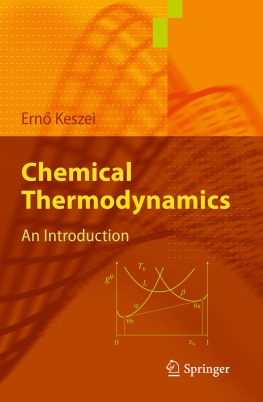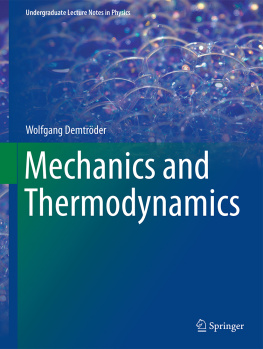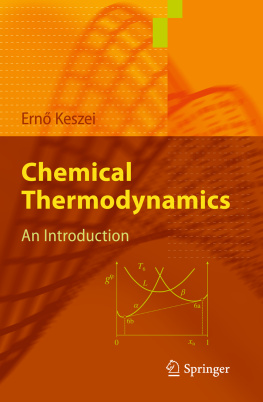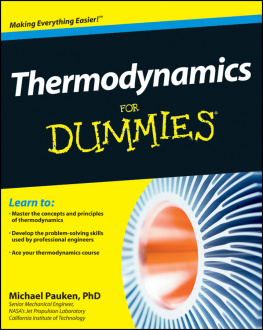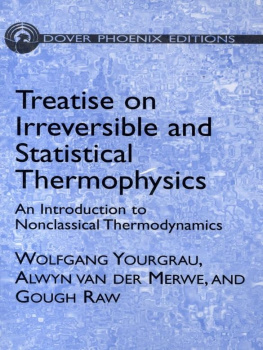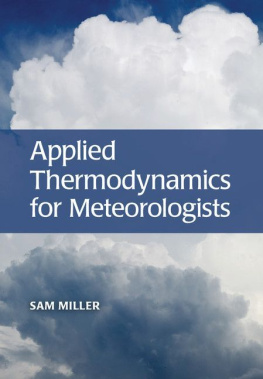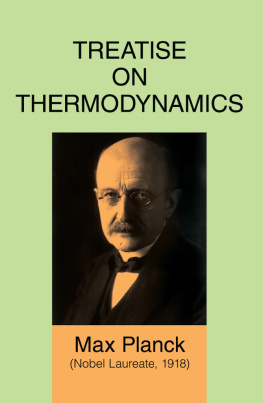Ern Keszei Chemical Thermodynamics An Introduction 10.1007/978-3-642-19864-9_1 Springer-Verlag Berlin Heidelberg 2012
1. Introduction
Physical chemistry deals with general properties common in different materials despite their chemical diversity. Properties referring to materials stored in a container i.e., materials at rest, without temporal changes have a special importance. These materials are told to be in an equilibrium state and are described by the science called thermodynamics . Equilibrium states can be very different depending on the circumstances; thus, one of the major aims of thermodynamics is to quantitatively characterize materials within different conditions and the changes accompanying their transition to a new state. The term thermodynamics has a historical origin. At the beginning of the nineteenth century, there was an attempt to understand the underlying principles of the efficiency of steam engines already in operation. The basic problem of the investigations was the transformation of heat into mechanical work. The Greek word [therme] means hotness (heat), while another Greek word, [dynamis] means the ability to act (power). Putting the two words together expressed the basic direction of this research. (The branch of mechanics dealing with movements is also called dynamics, originating from the same Greek word. Based on this, some authors criticize the name thermodynamics and propose thermostatics instead, as the underlying Greek word ( [stasis]=state) refers more directly to equilibrium states. These critics are not really relevant since actual names of branches of science are arbitrary, having a historical origin.) The term thermodynamics survived, even though this science explains a lot more than the efficiency of heat engines.
There are other branches of physics dealing with the characterization of equilibria; mechanics with equilibria of mechanical interactions, electrostatics with that of electric interactions, magnetostatics with that of magnetic interactions, and the calculations of interaction energies. Thermodynamics includes all these interactions but includes in addition the influence on interaction energies of the state of hotness (or coldness) of matter. It will be clear from molecular (or statistical) thermodynamics that the temperature-dependent energy involves changes in the molecular modes hidden at the macroscopic level. These molecular modes cannot be observed directly by measuring macroscopic quantities only, but the consequences of their changes are accessible for macroscopic observations. Thermodynamics differs basically from other branches of physics by considering this thermal energy and other thermal properties .
Chemical thermodynamics in addition to what physicists and civil engineers usually learn as thermodynamics deals with materials and properties where the chemical composition and its change are especially important. Quantitative relations concerning composition and its change are usually rather complicated. There is a special role of traditions and conventions established during the development of this science to describe the chemical aspects. This book after a concise introduction to the principles of thermodynamics concentrates on the thermodynamic description depending on the composition of equilibrium states and a detailed discussion of the underlying conventions. To establish the general principles is unavoidable before actual applications to chemically interesting systems, thus the first part of the book describes the very foundations of thermodynamics.
As mentioned before, the science of thermodynamics was developed by the interpretation of how steam engines, or in a wider sense and after later inventions, heat engines in general operate. This is the reason why its traditional treatment is based on conclusions drawn from the operation of those engines. This treatment is quite complicated and is not best suited to develop the principles underlying chemical applications. There is another possibility to set the foundations of a science, as it is common practice, e.g., in geometry, number theory, probability theory, or in physical sciences like mechanics, electrodynamics, and quantum mechanics. This is the postulatory foundation when a few postulates (or axioms ) are formulated, from which all theorems can be proved or all important relations derived. Already at the end of the nineteenth century, the American physicist Josiah Willard Gibbs proposed mathematically sound foundations of thermodynamics, but a genuine system of postulates has only been formulated in the middle of the twentieth century, mainly due to Lszl Tisza, an American physicist of Hungarian origin. The treatment of this book concerning the foundations of thermodynamics is closely related to the frequently referred textbook by Herbert B. Callen (a former student of Tisza) published 1960 with the title Thermodynamics, as well as its second edition published . In addition to this concerning especially statistical thermodynamics and chemical applications a number of other textbooks have been used as resources, which are listed at the end of the chapters.
Further Reading
Callen HB (1985) Thermodynamics and an introduction to thermostatistics, 2nd edn. Wiley, New York
Ern Keszei Chemical Thermodynamics An Introduction 10.1007/978-3-642-19864-9_2 Springer-Verlag Berlin Heidelberg 2012
2. Postulates of Thermodynamics
Abstract
In this chapter, postulates are announced in the form taken from the book of Herbert B. Callen, ready for actual thermodynamic calculations. The explanation of what a phenomenological or macroscopic treatment means is followed by the specification of equilibrium. Postulate 1 exactly defines thermodynamic equilibrium. Its important consequence the measurability of internal energy is described in details. Postulate 2 the criterion of equilibrium, and the existence of entropy is formulated in connection with composite systems and internal constraints. Postulate 3 specifies mathematical properties of the entropy function, like additivity, differentiability, and monotonity with respect to energy. An important consequence of these properties is the homogeneous first-order nature of this function. Extensive and intensive properties are also defined here. Euler relation and GibbsDuhem equation is derived and explained. There is a first mention of the fundamental equation which describes all possible states of a thermodynamic system. Postulate 4 specifies the scale of entropy and the possibility to completely determine its value. The second part of the chapter explains the relation of equations of state and the fundamental equation, followed by two model systems to demonstrate these relations; the ideal gas and the ideal van der Waals fluid.
Thermodynamics is a general theory; it deals with the properties of all kinds of matter where the behavior of a large number of microscopic particles (such as molecules, atoms, ions, etc.) determines the macroscopic properties. It is stated sometimes that this branch of science deals with the transformation of the thermal energy hidden in the internal structure and modes of movements of the enormously large number of particles that build up macroscopic bodies, into other forms of energy. As the microscopic structure of matter, the modes of movements and the interactions of particles have further consequences than simply determining the energy of a macroscopic body; thermodynamics has a more general relevance to describe the behavior of matter.

